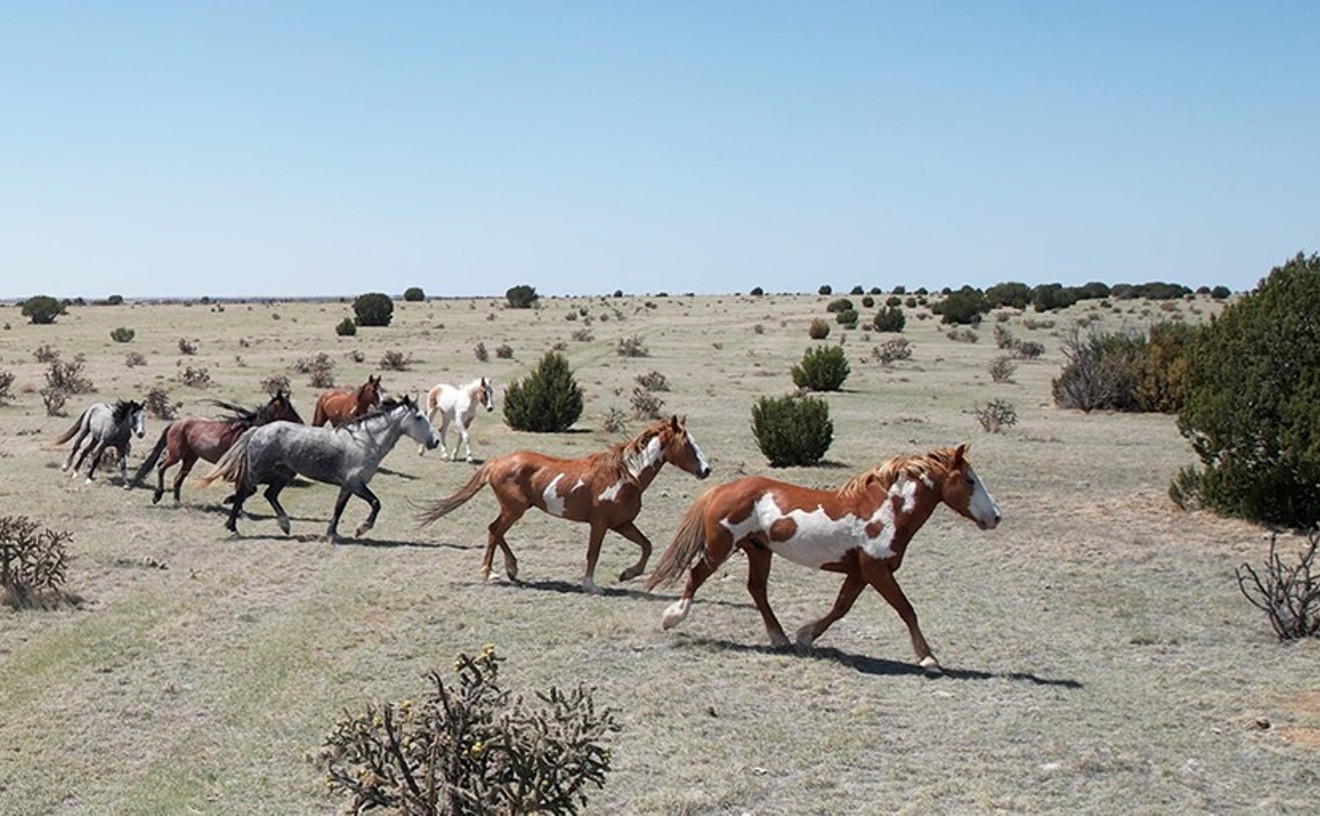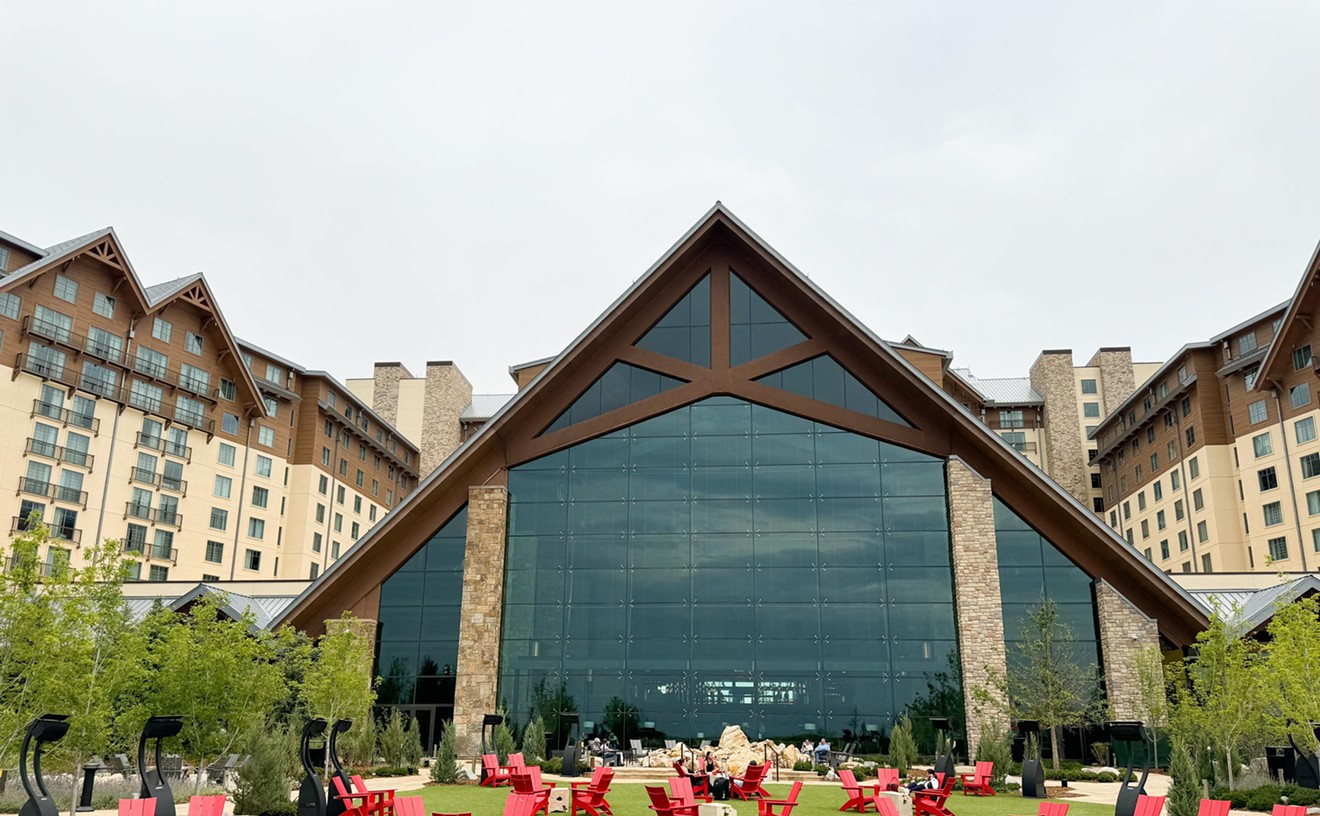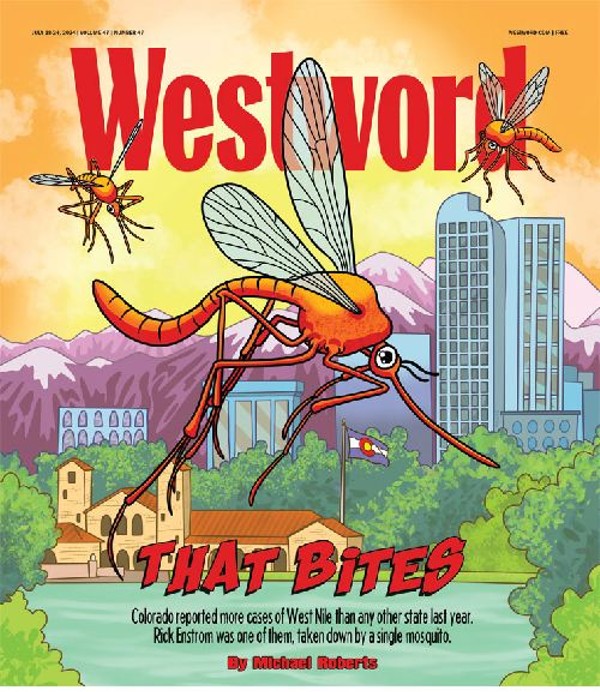The Mizel Center chose Einstein as the subject because the Denver Museum of Nature & Science was going to host a traveling blockbuster about the scientist that would coincide with "Creative Cosmos." Alas, as we now know, there is no Einstein exhibit at the DMNS; the powers-that-be went instead with Body Worlds 2, a presentation that features flayed and plastic-coated corpses. (I'll pass.) By the time the DMNS made its decision, however, the die had been cast at the Mizel.
Singer Gallery director Simon Zalkind wasn't in on the Einstein-theme selection, and you can tell, because it's an odd topic on which to hang an art show, and he knows it. The obvious choice would have been to mount an exhibition of those iconic black-and-white photos of Einstein, but they're in far-flung collections, so getting them here and insuring them would have tapped the Singer's budget. Zalkind briefly considered selecting artists who were working with high-tech methods -- literally using science to do their work -- but he decided instead to highlight a group of local painters and sculptors who refer to science in metaphorical ways.
The wall to the right of the Singer's entrance and the one directly ahead are both devoted to the late Vance Kirkland, the first of five artists represented here. Kirkland is surely at the top of everyone's list when it comes to local artists referring to science, as he not only did scores of paintings depicting outer space (some of which look suspiciously like the Hubble images that came back after his death), but also employed physics in his methods.
There are many beautiful pieces on loan from the Kirkland Museum, including the spectacular trio on the back wall: "The Energy of Explosions of the Sun 60 Billion Years B.C.," from 1978, covered with swirling masses of raised dots of pigments in yellow, orange and red; the remarkably similar "Explosions on a Sun 70 Billion Light Years from Earth," done in 1979; and, in between the two, their outstanding predecessor, "Space #21," from 1966, a classic dot painting of blue spheres.
Opposite the Kirklands, hanging on both sides of the angled walls, are paintings by Sue Simon, a longtime Spark co-op member. Simon has been doing mixed-media paintings for years that include mathematical equations and other references to science. In "Mathematical Universe: Twelve Equations That Matter," Simon took twelve small panels and used each one to illustrate a different equation, some mathematically, others graphically. The panels are finished in different shades, but the backgrounds were done as neutral monochromes ranging from cream to black. The piece looks great. I also liked those Simons in which the backgrounds are done expressively, such as "The Spectrum of the Cosmos," where a crisply rendered equation in black floats above a field of mostly horizontal smears of color.
On the other side of the Simons are two walls' worth of Clark Richert paintings, including some very unexpected new works, "A/C Project #1: Triacon" and "A/C Project #2: Enneacon." Both are large canvases that have been covered with polka dots in Necco wafer colors. The Richert dots resonate marvelously with the Kirkland dots hanging nearby. These new Richerts are lighter and airier than his earlier work, such as "Magic Tet" and "LA-AC Periods," both from 2001. In those older pieces, Richert laid out three-dimensional space, while the new ones have utterly flat pictorial space. I've always thought of Richert as one of the most relentlessly consistent artists in the area, and as different as these new works are from his earlier ones, they still follow the same idiosyncratic path of painting patterns that he's been following for decades.
Throughout the Singer are sculptures by promising emerging artist Joseph Shaeffer, who's been experimenting for the past few years with the use of magnets in his steel-and-hardware constructions. These sleek modernist sculptures refer to early-twentieth-century vanguard art, particularly constructivism. The self-taught Shaeffer is well aware of the aesthetic debt, as he reveals in the title "Spheric Cubes - Black-Vertical Sustention (Homage to Gabo)," which refers to early-twentieth-century constructivist Naum Gabo. Some of Shaeffer's work has an industrial aesthetic, such as "A Dark Tower - Manifest as Tension From the Confines of the Mind," in which a vertical pile is suspended by cables between four angled iron arms. It's very impressive.
The exhibit concludes in the atrium gallery, a nice space with a high ceiling that was given over to the work of Robert Mangold, the dean of Denver's modernist sculptors. Mangold is best known for his "Anemotive Kinetic" sculptures, which are multi-colored whirligigs that move with the wind, but for this show, he's exhibiting his "PTTSAAES" constructions. The odd title is an abbreviation of the phrase "Point Traveling Through Space at an Erratic Speed," and the sculptures of this name don't actually move, but simply imply movement. The idea is that the zigzagging metal forms follow imaginary trajectories of fantasy particles in a hypothetical space. To put it a different way, they follow the path of a bouncing ball. This room looks spectacular, and the colors of the sculptures -- blue, red and orange -- are thoroughly delicious.
Infinite in All Directions, at the Mizel's Singer Gallery, is absolutely great, but I expect nothing less from exhibition organizer Zalkind. He never disappoints me.
I only learned a few weeks ago of the sad news that Barbara Sudler Hornby was gravely ill. I was even more sad when I learned that she died of pneumonia early last week at the age of 81. Sudler Hornby was a major figure in historic preservation in Denver during the late twentieth century, which is why our paths crossed.
The demolition of so many important buildings during the oil boom led to the founding of a group called the Modern Architecture Preservation League. MAPL, as it was called, first rose up to challenge the planned demolition of the Central Library, a 1950s building by Burnham Hoyt and Arthur Fisher that still stands on the Civic Center. The league, including yours truly, prepared what could be called a guerrilla nomination for the National Register of Historic Places. I say "guerrilla," because MAPL went around the accepted channels in an attempt to cut the DPL off at the pass. It was in the context of this struggle that I first came to meet Sudler Hornby, who was then the president of the Colorado Historical Society and the state historic preservation officer. She was also a member of the Denver Landmarks Preservation Commission and had been a past president of Historic Denver.
In 1989-1990, the idea of preserving modern buildings like the Central Library was a radical one, and some of the most formidable enemies of the concept were the mainstream preservationists who were mostly concerned about nineteenth-century structures. They hated the full-blown modernism of the 1950s, as exemplified by Hoyt's landmark. But not Sudler Hornby; for her, it was a no-brainer. One of the sharpest pencils in the preservation box of that era, she instantly realized that MAPL was right, and that the most important buildings from the mid-twentieth century were historic and would need just as much help from preservationists as the earlier-era structures if they were going to survive. She even joined MAPL, giving the group instant credibility.
Allied with her friend and fellow modern-architecture enthusiast Rodd Wheaton of the National Park Service, Sudler Hornby brought the Colorado State Review Board, which she chaired, in line. There were a lot of people involved in saving the library, but Sudler Hornby was key because she lubricated the National Register listing process. The building received its historic-status designation, which gave it a gravity and importance it wouldn't have had otherwise and made it easier to save. (Though, sadly, not enough prestige to preserve its delightful and luxurious interior, which has been entirely lost.)
Born Barbara Welch in Hawaii, she moved to Boulder to attend the University of Colorado, where she earned a bachelor's degree in 1944. In 1950, she married Denver architecture star James Sudler, with whom she raised a son and a daughter. In the 1960s, Sudler was a proponent of vanguard modernism in his own practice and advocated for the preservation of all of Denver's historic buildings, which were then being clear-cut by the Denver Urban Renewal Authority. Barbara shared her husband's interest and joined his office in a managerial position, a move that started her career in historic preservation. Sudler died in 1982, and Barbara subsequently married Bill Hornby, a former senior editor at the Denver Post (and current editor emeritus there), whom she had met through historic preservation.
Sudler Hornby was a grand dame of the old school, and she spoke with that clipped tone only the old rich have. Diminutive and high-energy, she was very chic, with a bobbed haircut and clothes right off the pages of Harper's Bazaar. The last time I saw her, a couple of years ago, she was wearing huge, high-style sunglasses and a straw hat with a rolled brim. She could have been Jackie O (well, except for that red hair). That look she sported matched her equally chic house, a severe, modernist creation in the Country Club neighborhood that was designed by her late husband. The building sits behind other houses and is invisible from the street.
Despite her patrician background, Sudler Hornby was an instinctual feminist -- she was a woman, after all -- and as a result, she successfully built an old girls' network (to counter the old boys' network) at the CHS. This system is still essentially in place, though Sudler Hornby retired way back in 1990.
Her strong will and even stronger personality upset many people, both inside and outside the preservation community, and there were more than a few who feared her. But to me, Barbara Sudler Hornby was invariably charming, her remarks funny and insightful. I'm really glad I got the opportunity to know her.










